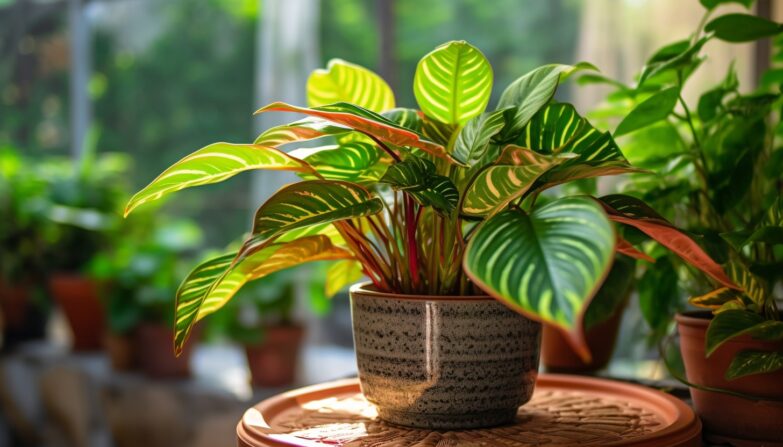Calathea Triostar is a popular tropical foliage plant known for its striking leaves that feature shades of pink, green, and cream. Native to Brazil, these plants are commonly grown indoors as they require warm temperatures and a consistent humidity level.
Their unique foliage makes them a popular choice for adding color and texture to any room. They have a bushy growth habit and can grow up to 2 feet tall, making them a great option for filling in empty corners or adding depth to a plant display.
It’s important to note that Calathea Triostar can be a bit finicky when it comes to care and requires specific growing conditions to thrive. In this guide, we’ll walk you through everything you need to know to keep your Calathea Triostar healthy and looking great.
Light and Temperature Needs
Calathea Triostar requires bright, indirect light to thrive. Direct sunlight can scorch the leaves, while low light levels can cause stunted growth and fading of the plant’s vibrant colors. Place your Calathea Triostar near a window with a sheer curtain to provide the perfect amount of filtered light.
These plants prefer temperatures between 65-80°F (18-27°C), making them ideal for growing indoors. Keep your Calathea Triostar away from drafty windows or air conditioning vents as they are sensitive to rapid temperature changes.
Watering and Soil Requirements
Calathea Triostar requires consistently moist soil to thrive, but it’s important not to overwater the plant. Allow the top inch of soil to dry out before watering again, as soggy soil can lead to root rot. Use a well-draining potting mix with peat or coconut coir to ensure proper drainage.
When watering, use room temperature water as cold water can shock the plant’s roots. Avoid using hard tap water, as the high mineral content can damage the leaves. Instead, use filtered or distilled water, or allow your tap water to sit out overnight before using it to water your Calathea Triostar.
Feeding Your Calathea Triostar
Calathea Triostar requires regular fertilizer to maintain its vibrant colors and lush foliage. Use a balanced, water-soluble fertilizer once a month during the growing season (spring and summer) and reduce the frequency to every two months during the fall and winter months. Be sure to dilute the fertilizer to half the recommended strength to avoid burning the delicate roots.
Humidity and Environment Guidelines
Calathea Triostar requires a consistent humidity level of 50% or higher, which can be difficult to maintain in some indoor environments. To increase humidity levels, mist the leaves daily or place the plant on a tray filled with pebbles and water. Be sure the pot is sitting on top of the pebbles and not in the water to prevent root rot.
It is also important to keep these plants away from cold drafts and hot, dry air, as both can cause the leaves to curl and dry out. Consider using a humidifying device or placing your Calathea Triostar near a humidifier to maintain the ideal moisture level.
Common Pests and Diseases
Calathea Triostar is relatively resistant to pests and diseases, but some issues can arise if the plant is not properly cared for. Spider mites can infest the plant in dry conditions, while mealybugs and scale insects can feast on the sap and damage the leaves.
To prevent infestations, regularly inspect your Calathea Triostar for any signs of pests and use an organic insecticidal soap or neem oil to treat any issues. If your plant is struggling with disease, remove any affected leaves and adjust your watering and environment habits to prevent future problems.
Propagation Techniques
Calathea Triostar can be propagated through stem cuttings or division. Stem cuttings should be taken in the spring or early summer when the plant is actively growing and the roots have the best chance of forming. Cut a section of stem with at least one leaf attached and place it in a small pot with moist peat-based soil. Cover the pot with a plastic bag and place it in a bright spot out of direct sunlight.
For division, carefully remove the plant from its pot and gently tease apart the root system to separate individual plants. Make sure each plant has a healthy root system and a few leaves. Replant each section into its own pot with fresh soil and water thoroughly.
Tips for Pruning and Maintenance
Regular pruning is necessary to prevent Calathea Triostar from becoming too leggy or overgrown. The best time to prune is in the spring when the plant is actively growing. Use a clean pair of scissors or pruning shears to remove any dead or damaged foliage or to shape the plant to your desired size.
It’s also important to wipe down the leaves regularly to prevent dust and debris from accumulating, which can affect the plant’s ability to absorb light. Use a damp cloth or sponge to gently wipe down each leaf, taking care not to damage them.
Overall, Calathea Triostar is an eye-catching plant that can add a pop of color and interest to any indoor space. Although it requires some specific care conditions, with a little bit of effort, your Calathea Triostar can thrive and be a beautiful addition to your indoor garden.

